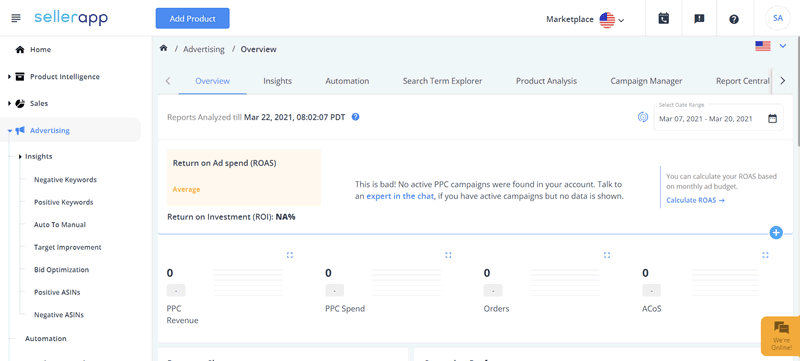Amazon PPC campaigns are an effective way to drive sales and consequently increase profits. In June 2021, the average cost-per-click (CPC) of ads on Amazon in the United States stood at $1.20. A year earlier, it amounted to $0.79, which signifies a growth rate of nearly 52 percent year-on-year (source). This is a testament to the popularity and usage of Amazon by ads by sellers.
Table of Contents
All registered sellers on Amazon leverage PPC ads but it’s the way you strategize them that matters. You need to take into account all aspects of PPC campaigns in order to create one that you can profit from.
Firstly, you need to know how to calculate profitability. So, what is the best way to do this? Most of the time, ACoS (ACoS = Total ad spend ÷ Total sales) is the only way to measure success and calculate profitability. ACoS determines your advertising budget. You need to be smart while budgeting because you might either set it too high or too low and either could have dire consequences. It could result in you losing out on the visibility and reach that your product or brand needs to generate awareness and sales or eat into your profits. What you need to do is ensure that you have a TACoS that is enough to drive your conversions and increase visibility.
In addition to ACoS, you also need to take the following factors of each advertised product into consideration:
- ACoS
- Discounts
- Product’s final selling price
- Shipping costs
- Amazon FBA fees
- Cost of manufacturing
A combination of all these factors is used to calculate your true profit margins. For a seller earning a 30% profit margin on Amazon excluding PPC, you will be breaking even from your PPC campaigns as long as you are not spending 30% off your profit margin.
Here are some powerful strategies to create profitable Amazon PPC campaigns:
Advertise products that have well-optimized detail pages
The product detail page should be optimized with a befitting title, description, images, price, features, etc. Your product title should catch the shoppers’ attention by matching their search queries. The title gives shoppers the foremost information about your product and it should have all the relevant keywords.
The images used in the product detail pages should be of high quality and include pictures from different angles as well as lifestyle images. The description should have bullet points with keywords used in every part to optimize it well for Amazon SEO. This ensures that your ad campaigns target top-performing keywords on your product detail page.
All these factors in addition to the right price and A+ content are important to do before deciding to direct traffic to your listing. There’s no point in sending shoppers to a listing without the possibility of conversion. A well-optimized page works towards convincing shoppers to make a purchase after they click on your ad and get directed to your listing. Thus you earn more conversions and a better ROI.
Organizing campaigns
Whether you run a single campaign or multiple ones, they have to be well organized. The best way to measure your profits is only if your campaigns are structured well. Different Amazon businesses have different ways to go about structuring their campaigns according to the niche that they sell in. So, there isn’t a single universal one that everyone can choose.
You can create ad groups according to the product category, brand, or even best-seller products. These can be further organized along with the likeness of products and keywords. Each of these ad groups should target broad, phrase, and exact match types. Additionally, whether your products are FBA or FBM, or both, make sure to include all of these listings in your PPC campaigns. This is so that your ads continue to run irrespective of the fulfillment option you’ve chosen for that period.
Organizing campaigns may not seem as important in the initial stages. However, you will realize how much you can benefit from it later because it makes it very easy to scale your business and earn profits that can be easily measured.
Automatic campaigns in conjunction with manual campaigns
Sellers need to understand that running only automatic or only manual campaigns cannot yield results as good as a combination of the two. To ensure that you’re setting up profitable campaigns, run an automatic one for at least 2 weeks. You must then analyze customers’ search terms or data from the Search Term Report of that campaign.
It will help you discover top-performing long-tail keywords with a lot of conversions as well as those that are underperforming. You must then create a manual campaign and add the top-performing keywords into it while excluding the ones that are non-converting. Conduct a good amount of keyword research with everything you have so far. This will help you find more related keywords that have lower CPC, the potential to gain impressions and drive conversions.
As stated above, run 3 different kinds of ad groups by match type. Decide on your budget for both campaigns along with the duration for which you want to run them. The bids for your manual campaigns should be higher than the ones for automatic campaigns. This ensures a lower ACoS in addition to protecting you from exhausting your advertising budget.
Sponsored ads placements
On Amazon, there are 3 different placements for ads – top of search, rest of search, and product detail pages. Advertisers have a good amount of control over the placement of their ad or where it displays, according to how much they’re ready to budget for it, so it is important to optimize accordingly.
For Amazon PPC campaigns, there is a base bid on which you can make adjustments if you want to display on top of search (highest cost-per-click) or on product listing pages. However, this adjustment option is not available for placement on the rest of search (lower bids) where the placement will be according to your base bid. Bidding for good placements is also important as sponsored ads that show up on product detail pages are usually similar or related to the product whose listing it is. This makes way for you to have ads on your competitors’ listings and it is a great way to gain exposure.
Amazon provides detailed reports which throw light on which product placements have raked up the best results for you. You can use these reports to optimize your campaigns and adjust bids accordingly while creating new ones. This guarantees a good conversion rate.
Consistently regulate your campaigns
It’s important to actively optimize your PPC campaigns with high potential and profitable keywords and eliminate negative search terms and those that don’t bring in any conversions. SellerApp’s campaign manager helps you save time and money without the risks of trial and error.
You can compare and analyze KPIs and get useful insights at the campaign, ad group, and keyword level. With the campaign manager, you can effectively gauge the performance of your sponsored ads at the account level in terms of PPC revenue, ACoS, number of orders and conversions, CTR, clicks, etc. You can also assess the performance of important metrics at the campaign level.
You can also obtain reports for any given time and see how well you’re advancing towards your advertising goals. With precise analysis at each level, you can assess your performance and profits and adopt measures to improve on the metrics that can increase your profitability.
Conclusion
There are a ton of strategies that sellers and advertisers can use to create profitable PPC campaigns on Amazon. If you’ve been running ads but not getting a good RoAS, worry not. Advertising on Amazon poses a lot of opportunities for sellers to give their sales and conversions that much-needed boost. The abovementioned tips are meant to act as a comprehensive guide. Go ahead and try them out now to see some remarkable results!
More posts
About the author

Arishekar N
Arishekar is a leading SEO and digital marketing expert in India, He is the Senior Director of Marketing and Growth at SellerApp.com, an e-commerce data analytics solution





